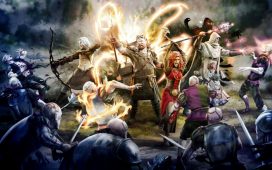This year, veteran video game developers Garry Kitchen and David Crane released a new game for the Atari 2600 – despite the fact that the console was discontinued some 30 years ago. And they’re not the only ones. Companies such as Limited Run Games and Strictly Limited Games are manufacturing brand new cartridges, and sometimes never-before-released games, for consoles that predate the smartphone. “The market’s not remotely dead for these consoles,” says Josh Fairhurst, head of North Carolina-based Limited Run. “There’s a lot of demand, and it’s only growing.”
Prices for retro games have gone through the roof in recent years, as evidenced by a recent slew of record-breaking auction bids for classic titles, including the sale of a mint copy of Super Mario 64 for $1.5m (£1.1m). The supply of old games is limited, and demand is increasing: not just from older people who want to collect games they remember from their youth, but also from those who weren’t even born when the Sega Mega Drive was cutting-edge. “New generations want to go back and experience the classics and own them,” says Fairhurst. “There are game collectors born every day.”

For him, producing new cartridges is a way to make these games available to people who can no longer afford the eye-watering prices that collectors are paying. He gives the example of Shantae on the Game Boy Color, the first title in a now popular series. Original copies of this rare game sell for around $600, Limited Run’s new cartridges cost a fraction of that.
But why buy a cartridge when hundreds of classic games are already available to purchase digitally on modern consoles, and many more can be played for free through legally dubious emulation? It’s about authenticity, says Dennis Mendel, head of Strictly Limited Games in Stuttgart, Germany: “The real deal is the original console.” There’s also the tangibility of actually owning something, he adds. With a digital game, the customer simply buys a licence to play the title rather than owning it outright. But his company’s cartridges “can’t be updated through a digital update, and you can’t remove the rights to play them.”
Then there’s the unexpected cool factor of physical media, which Fairhurst likens to the way vinyl has been embraced by younger people: “Kids raised in the digital era, they’re yearning for some of this physical stuff. And it’s becoming cool again, in a sense, because it’s different than what they’re used to.”

Companies aren’t just re-releasing classic games on brand new cartridges – they’re also creating new titles for old machines, and even unearthing cancelled games that never made it to market first time around. Strictly Limited released Ultracore for the Mega Drive in 2019, a game by Swedish developer Dice (now famous for the Battlefield series) which was cancelled by its publisher in 1994, just before release. The production run of 2,000 cartridges sold out almost immediately. “We underestimated the power of retro games at that time,” says Mendel.
Limited Run has also released brand new titles for old systems, such as GALF and Jay and Silent Bob: Mall Brawl on the NES. Fairhurst says retro hardware appeals to developers because games can be created with a team of just two or three people: “The games don’t have to be giant in scope, and they can still be fun, they can still be engaging.”
For Garry Kitchen, however, returning to work on the Atari 2600 was all about the challenge of making the best possible game for the system. Kitchen worked at Activision in the early 1980s, and along with his brother Dan and Activision co-founder David Crane, he established Audacity Games earlier this year. The company has just released Circus Convoy, a game three years in the making. “It was glorious, because there was nobody breathing down our necks … We worked on it until it was perfect,” says Garry. He has been bowled over by the response. “We get so many messages that are just: ‘I can’t tell you how important it was to me, it was like I was 10 years old again, waiting for my cartridge to come in the mail.’”

Kitchen is quick to admit that it’s more about the passion than money. Margins are tight when it comes to creating these bespoke cartridges, and production runs are typically small, ranging from around 2,000 to 10,000 units. Fairhurst says that Limited Run works with a trusted supplier to create custom PCB boards and plastic injection moulds for their releases, a process that doesn’t come cheap. “The actual cost of these things can be $30–40, and the top anybody will pay for them is maybe $55. And then you have to factor in that we are splitting that amount with the software licensor. At the end of the day, we might make $2 for every one of these things we make, so it’s certainly not super lucrative.”
He notes that bootleg reproduction cartridges often sell for much less, but are usually made from cheap components that could potentially damage a console or even catch fire. And of course, he says, the game’s developers aren’t getting any royalties from bootlegs. Mendel agrees that financially supporting game creators is essential for building a sustainable market. If developers receive royalties from a new cartridge release, he says, they may think, “hey, there’s interest in this, let’s make a sequel, or let’s create a new game”.
Mendel thinks there’s a certain social responsibility to keeping these old games and systems alive so that people can appreciate how games have evolved, in the same way that movie lovers appreciate the films of Charlie Chaplin. But more simply, Fairhurst says, people just like owning something tangible. “They like the feel of opening a box, looking through a manual, putting something up on their shelf, and building a collection. There’s just something appealing about that.”














